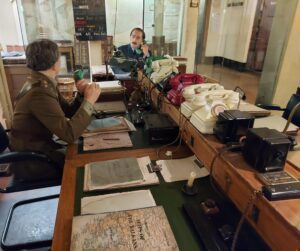Winston Churchill and the Cabinet War Rooms
During the Second World War a series of underground rooms were created below government offices at Whitehall. It was from there that the Prime Minister, his Cabinet, and military leaders could meet in safety to direct the war effort while London was being bombed. The facility was known as the War Rooms.

Members of the War Cabinet sat around a table arranged in a square, with Prime Minister Winston Churchill at the head of the table. The three heads of the armed forces sat in the centre of the square facing Churchill.
London had been bombed by enemy aircraft during the Great War, between May 1915 and August 1918. Until then the city had been immune from direct conflict. Britain was island, safe from attack by foreign enemies; and for centuries battles within the British Isles took place away from the capital. Britain’s fortifications were focussed on defending from invasion by sea, and it was unprepared for attack from the air. Hundreds of people were killed during the air raids of the First World War, most notably 18 children when a bomb fell in June 1917 on a school at Poplar, East London. These were very small numbers of casualties compared with the thousands of soldiers being killed every day on the front lines of the war in France and Belgium. Yet bombs dropping from the air brought home to Londoners the realities of modern warfare and caused great panic. They gave the enemy little military advantage, however, except that a significant amount of effort, and a vast amount of munitions, were committed to Home Defence and thus diverted away from the war on the Western Front.

The memory of bombs dropping on the capital remained in the minds of Londoners for years after the Great War ended in 1918. The threat of bombing in any future conflict worried the governments and civil servants of the 1920s, with the Air Ministry predicting up to 200,000 casualties caused by bombing in just the first week of any future war. Therefore, a limited amount of preparation was put in place should it ever happen in the future. In the early 1920s a plan was devised to evacuate from Central London the prime minister, government and essential staff if ever war was declared. These included sites in North West London and further to the North of England.
With the rise to power of Adolf Hitler and the Nazi party in the 1930s, and their strong nationalist rhetoric, war with Germany began to seem like a possibility. The minds of civil servants became more focussed on the idea of protecting key personnel. By then there was concern that the general population of London would feel abandoned should the government depart to a safe place, so in the summer of 1938 a new plan was put in place.
There was basement storage space below the New Public Offices on Great George Street, what is now the Treasury, above which the building had been constructed with a strong, steel frame. The location sat between the prime minister’s office at Downing Street and the Houses of Parliament across on the other side of Parliament Square. If an air raid was expected it was just a few minutes walk from either of those places. It was decided to use this to create a safe place from which the prime minister, his cabinet, and the heads of the armed services could direct operations when necessary. Their whereabouts, and thus the existence of this underground space, had to be kept secret from the enemy, but construction work in the basement of an existing government office could be undertaken without suspicion. Work was carried out under the direction of Sir Hastings Ismay and Sir Leslie Hollis, respectively Secretary and Assistant Secretary to the Council for Imperial Defence.
The series of rooms were simply an adapted basement spread over two floors, rather than a purpose-built bunker. Initial preparations included strengthening by the addition of solid wood pillars to prop up the ceilings in case of bombing. What became known as the War Rooms were fully operational for the use of Prime Minister Neville Chamberlain and his cabinet at the end of August 1939, a week before Germany’s invasion of Poland the following month and the declaration of war. Perhaps to test the facilities, Chamberlain and his Cabinet held one meeting in the War Rooms in October 1939.


